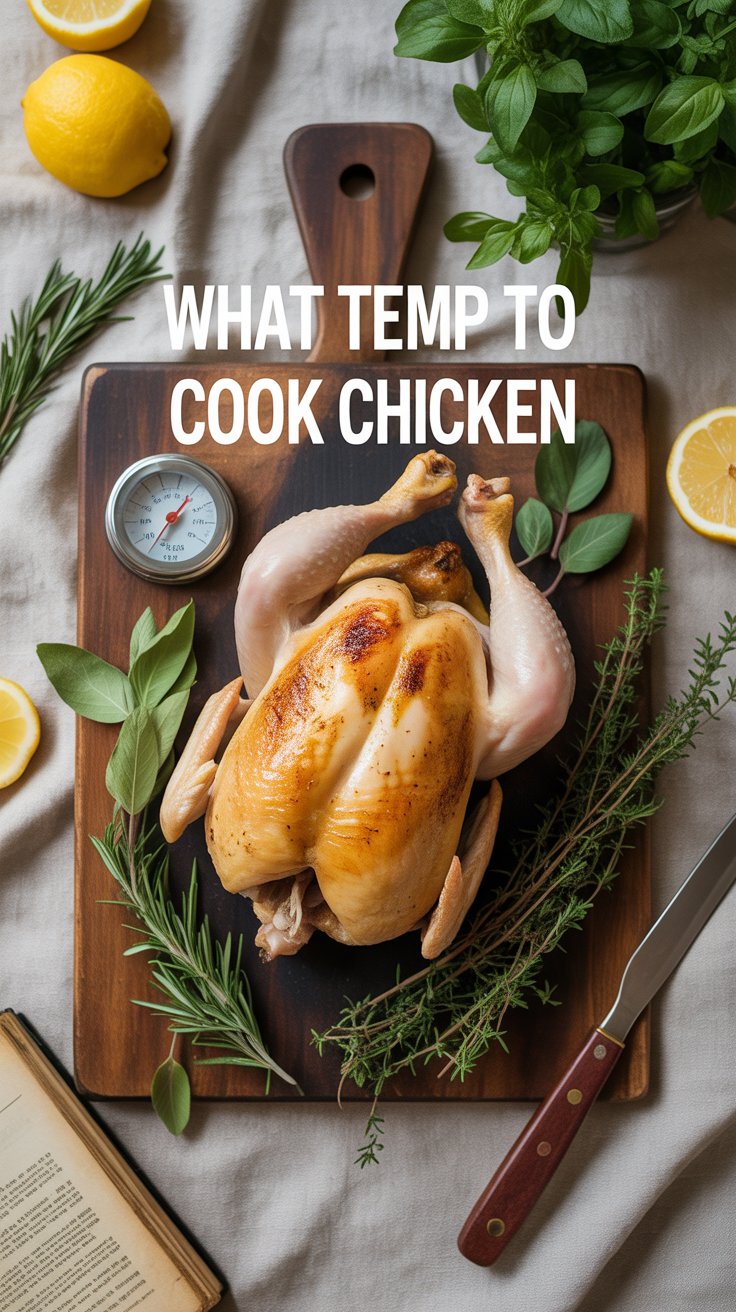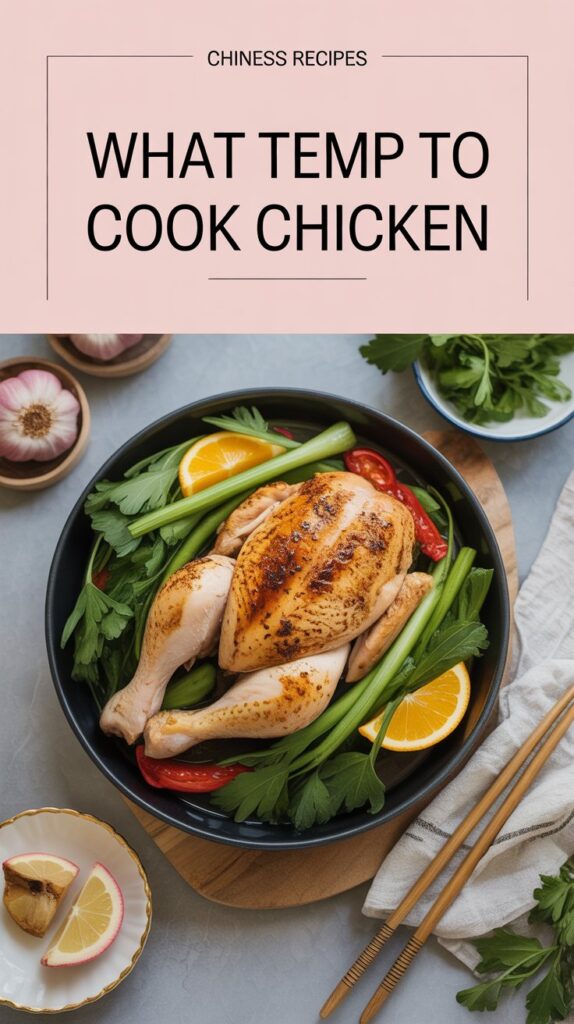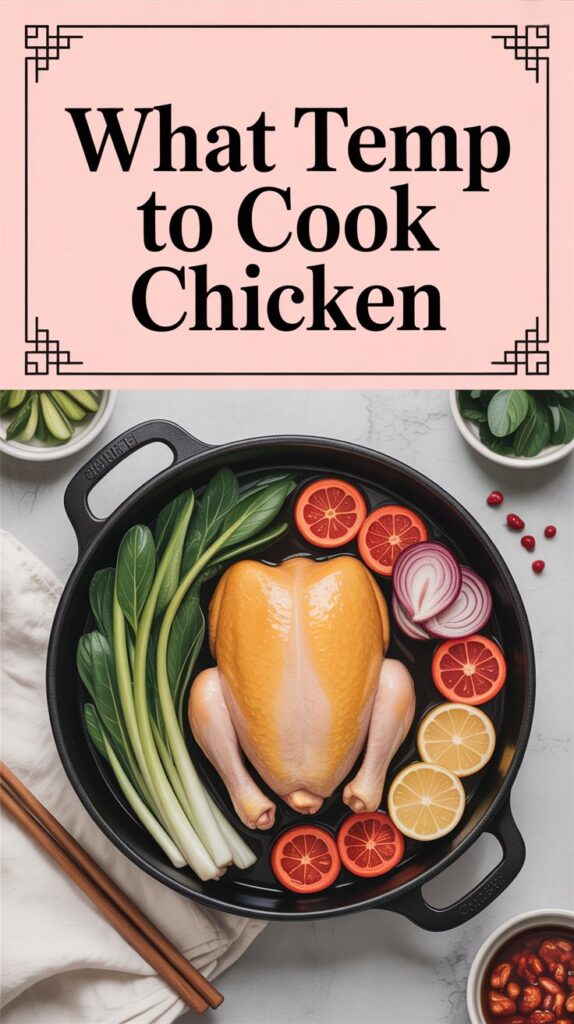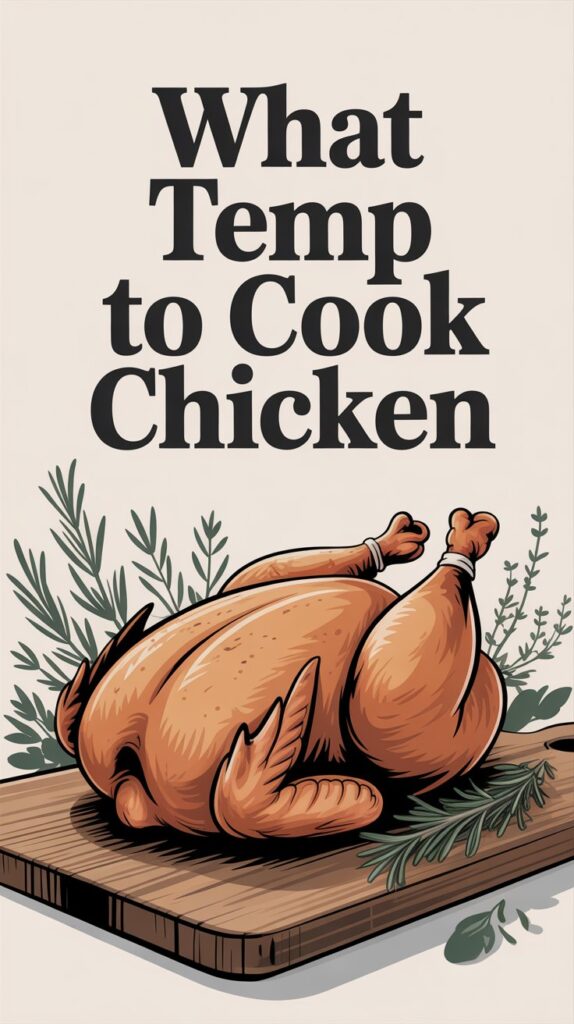Cooking chicken perfectly not only enhances its taste but also ensures it is safe to eat. The primary concern when preparing chicken is to reach the correct internal temperature, which helps kill harmful bacteria. It’s essential to know the appropriate cooking temperatures to guarantee both delicious and safe meals.
The USDA recommends that all chicken should be cooked to a minimum internal temperature of 165°F (74°C). This ensures that harmful pathogens like Salmonella and Campylobacter are effectively neutralized. Below, we will explore the optimal temperatures for different chicken cuts and cooking methods. Following these guidelines will help you serve chicken that’s both tasty and safe.
Optimal Cooking Temperatures
Whole Chicken
When roasting or grilling a whole chicken, the general rule of thumb is to cook it until the thickest part of the breast or thigh reaches 165°F (74°C). However, for the best texture and juiciness, cooking to a temperature of 170°F to 180°F (77°C – 82°C) is recommended. This allows for a more tender, moist end result.
Chicken Breasts
Chicken breasts are lean, and if overcooked, they can become dry. The ideal temperature for cooked chicken breasts is also 165°F (74°C). For the juiciest chicken breasts, consider taking them off the heat when they reach 160°F (71°C) and letting them rest. Carryover cooking will raise the temperature to 165°F (74°C), keeping the meat moist.
Chicken Thighs and Drumsticks
Dark meat, such as chicken thighs and drumsticks, can handle slightly higher temperatures. Cooking these parts to 175°F to 180°F (80°C – 82°C) provides the best flavor and tenderness. This higher temperature allows the fat within the meat to render, resulting in a juicier bite.
Ground Chicken
Ground chicken must be cooked thoroughly for safety. The recommended internal temperature is 165°F (74°C). When using ground chicken in recipes, utilize a meat thermometer to ensure it has reached the appropriate temperature all the way through.
Chicken Wings
For chicken wings, the optimal temperature is again 165°F (74°C). They are often cooked at higher temperatures for crispiness. When deep frying or baking wings, many cooks aim for an internal temperature of about 175°F (80°C) to achieve that perfect balance of crispy skin and tender meat.
Cooking Methods and Their Temperatures
| Cooking Method | Recommended Temperature |
|---|---|
| Grilling | 165°F (74°C) |
| Baking | 165°F (74°C) for breasts, 175-180°F (80-82°C) for thighs |
| Frying | 165°F (74°C) for wings, 175°F (80°C) for extra crispiness |
| Broiling | 165°F (74°C) for all cuts |
| Slow Cooking | 165°F (74°C) minimum |
Importance of Using a Meat Thermometer
Using a meat thermometer is crucial to achieving the correct internal temperature. Investing in a good quality digital thermometer can make your cooking both convenient and secure. Simply insert the thermometer into the thickest part of the meat, avoiding bones. This will give you an accurate reading and peace of mind.
Additionally, remember to let your chicken rest for a few minutes after cooking. This practice allows juices to redistribute, resulting in tender and flavorful meat. Always cross-check the temperature for accuracy, especially when you’re preparing chicken for family or guests.
For additional tips on safe chicken preparation, visit the USDA Food Safety and Inspection Service. They provide comprehensive guidelines on cooking temperatures and safe kitchen practices.
Understanding what temperature to cook chicken will not only improve your culinary skills but also keep you and your family safe from foodborne illnesses. By sticking to these recommended temperatures, you can enjoy delicious chicken dishes with confidence.
The Impact of Cooking Methods on Chicken Texture and Flavor
When it comes to preparing chicken, the method you choose significantly influences its texture and flavor. Different cooking techniques bring out unique characteristics in the meat, affecting everything from juiciness to tenderness. Understanding these differences can enhance your culinary skills and result in more delicious meals.
Whether you prefer grilled, roasted, or sautéed chicken, each method provides specific benefits and impacts the final dish. Here’s a closer look at some popular cooking methods and how they affect chicken.
Grilling Chicken
Grilling chicken is a popular choice for its smoky flavor and appealing char. The high heat cooks the meat quickly, creating a delicious crust while keeping the inside moist.
- Flavor: Grilling infuses a rich, smoky flavor that pairs well with marinades and spices.
- Texture: The direct high heat creates a crispy skin, while the meat remains juicy and tender inside.
- Cooking Temperature: Aim for an internal temperature of 165°F (75°C) for safety and optimal flavor.
Roasting Chicken
Roasting chicken involves cooking it in an oven at a moderate temperature. This method allows for even cooking and a beautifully browned exterior.
- Flavor: Roasting develops deep, caramelized flavors as the natural sugars in the chicken brown.
- Texture: The dry heat creates a crispy skin while allowing the meat to cook through evenly.
- Cooking Temperature: Again, aim for 165°F (75°C) as the safe cooking point.
Sautéing Chicken
Sautéing is a quick and effective way to cook chicken, often using a small amount of oil over high heat. This method is great for stir-fries and quick meals.
- Flavor: Sautéing allows for the addition of herbs, spices, and vegetables, enhancing the overall taste.
- Texture: The quick cooking time keeps the meat tender but can lead to dryness if overcooked.
- Cooking Temperature: Cooking should also reach 165°F (75°C) to ensure safety.
Other Notable Cooking Methods
While grilling, roasting, and sautéing are common, several other methods can transform chicken:
- Brining: Soaking chicken in a saltwater solution before cooking can enhance moisture retention, leading to juicier meat.
- Poaching: Cooking chicken gently in simmering water or broth keeps it moist and tender, perfect for salads or sandwiches.
- Braising: This method combines both cooking techniques by first browning the meat, then slow-cooking it in liquid, creating incredibly tender chicken.
As you experiment with various methods, consider the impact of additional ingredients such as marinades and seasonings. For example, marinating chicken before grilling can enhance its flavor profile, while using aromatic herbs during roasting can elevate the dish further.
Choosing the Right Method
The right cooking method ultimately depends on personal preference and the dish you plan to create. Factors such as time, texture, and flavor are vital in deciding how to prepare chicken.
For a quick weeknight dinner, sautéing might be ideal. If you’re hosting a gathering, roast a whole chicken to impress your guests. For summer barbecues, grilling is a favorite.
Ultimately, experimenting with various methods allows you to discover what you enjoy the most. Don’t hesitate to mix techniques or adjust flavors to suit your palate.
For further insights and tips about cooking chicken and different recipes, explore resources like Chicken Farmers of Canada or Food Network’s chicken section.
The cooking method you choose for chicken significantly impacts its flavor and texture. By understanding the characteristics of each technique, you can create delicious and well-cooked chicken every time.
Common Mistakes When Cooking Chicken and How to Avoid Them
Cooking chicken can be simple, but many home cooks encounter common mistakes that affect the taste and safety of their meals. Avoiding these pitfalls can elevate your cooking game and ensure your chicken dishes are juicy and delicious. Here are some of the most prevalent mistakes when cooking chicken and tips on how to sidestep them.
Not Using a Meat Thermometer
One of the biggest blunders is not checking the internal temperature of the chicken. Many people rely solely on cooking times, which can lead to overcooked or undercooked meat.
The safe internal temperature for chicken is 165°F (74°C). To avoid guessing, use a meat thermometer to ensure your chicken is fully cooked without drying it out. Insert the thermometer into the thickest part of the meat, avoiding the bones for an accurate reading.
Cooking Cold Chicken Straight from the Fridge
Cooking chicken straight from the fridge can result in uneven cooking. When chicken is cold, the outer layers cook faster than the inside, leading to dry exteriors and raw centers.
To prevent this, let the chicken sit at room temperature for about 20-30 minutes before cooking. This helps it cook more evenly.
Skipping the Marinade
A common mistake is not marinating chicken. Marinades add flavor and moisture, enhancing the overall taste of your dish.
Consider using a simple marinade with oil, acid (like vinegar or lemon juice), and herbs or spices. A few hours of marinating can take your chicken from ordinary to extraordinary. Just remember to marinate in the fridge, not at room temperature.
Overcrowding the Pan
When sautéing or roasting chicken, overcrowding the pan can steam rather than sear the meat. This often results in a soggy texture rather than achieving a nice crispy exterior.
To avoid this, cook chicken in batches if necessary, giving each piece enough room to brown evenly. This technique is especially important if you’re working with larger cuts or multiple pieces.
Trimming Away Too Much Fat
While cleaning chicken, some cooks mistakenly remove too much fat. Fat contributes to flavor and moisture, making the chicken much more enjoyable.
Instead of trimming all the fat, consider leaving a little on. This can help create a more succulent result. If you’re concerned about calories, you can always trim excess fat after cooking.
Not Resting the Chicken
Another mistake is cutting the chicken right after cooking. This can result in all the juices running out, leaving you with dry meat.
Allow your chicken to rest for about 5-10 minutes after cooking. This helps the juices redistribute throughout the meat, ensuring a tender bite every time.
Ignoring Carryover Cooking
Many cooks are unaware of carryover cooking; it refers to the temperature rise in meat after it’s removed from heat. Chicken can increase in temperature by several degrees during resting.
Be mindful of this when using a meat thermometer, as you may want to pull your chicken off the heat just before it hits the target temperature. Take it off at around 160°F (71°C), allowing it to reach the safe 165°F during rest.
| Mistake | Tip |
|---|---|
| Not using a meat thermometer | Check chicken’s internal temperature; aim for 165°F (74°C). |
| Cooking cold chicken | Let chicken sit at room temperature for 20-30 minutes. |
| Skipping the marinade | Use simple marinades for added flavor. |
| Overcrowding the pan | Cook in batches to allow even browning. |
| Trimming too much fat | Leave some fat for moisture and flavor. |
| Not resting the chicken | Let chicken rest for 5-10 minutes before slicing. |
| Ignoring carryover cooking | Remove the chicken from heat at 160°F (71°C). |
By avoiding these common mistakes, you can enhance both the flavor and safety of your chicken dishes. For more tips on cooking chicken properly, check out resources like Chicken Farmers of Canada and USDA Food Safety and Inspection Service. Happy cooking!
Marinades and Brines: Enhancing Chicken Flavor at the Right Temperature
When it comes to cooking chicken, flavors can be elevated dramatically through the use of marinades and brines. Understanding the right temperatures for cooking chicken, along with how to utilize marinades and brines effectively, makes all the difference in achieving mouthwatering results.
Marinades are seasoned mixtures of acids, such as vinegar or citrus juice, combined with oil, herbs, and spices. They work by penetrating the meat and infusing it with flavor. As chicken cooks, the acids in the marinade help break down proteins, making the meat tender and juicy. Here’s how to maximize the benefits of marinades:
- Choose the Right Ingredients: A balance of acidic, oily, and flavorful components is key. Common marinade ingredients are:
- Acids: lemon juice, vinegar, yogurt
- Oils: olive oil, vegetable oil
- Flavorings: garlic, ginger, herbs (thyme, rosemary), spices (paprika, cumin)
- Marinate for the Right Time: While soaking chicken overnight is ideal, even a quick 30-minute marinade can impart flavor. Over-marinating, particularly in acidic mixtures, can lead to mushy textures.
- Right Temperature for Cooking: While marination enhances flavor, it’s important to cook chicken to the proper temperature for food safety. Chicken should reach an internal temperature of 165°F (73.9°C) to eliminate harmful bacteria.
On the other hand, brining involves soaking chicken in a saltwater solution, sometimes accompanied by sugar and spices. Brining enhances moisture retention during the cooking process, leading to succulent and juicy chicken. Here are the essentials for brining:
- Salt Concentration: A typical brine solution contains 1/4 to 1/2 cup of salt per gallon of water. Adding sugar can further enhance flavor and aid in the browning process.
- Brining Time: Smaller cuts like chicken breasts may need only 30 minutes to 1 hour, while whole chickens benefit from several hours in the brine.
- Cooking Temperature: Just as with marinated chicken, the key is cooking it to at least 165°F (73.9°C) for safety. The added moisture from brining can allow for slight variations, enabling you to cook at slightly lower temperatures for longer periods.
To visualize the differences and essentials between marinades and brines, here’s a comparison:
| Aspect | Marinades | Brines |
|---|---|---|
| Purpose | Adds flavor | Adds moisture |
| Main Component | Acidic mixtures | Saltwater solution |
| Typical Duration | 30 mins to 24 hrs | 30 mins to several hours |
| Preferred Cooking Temp | 165°F (73.9°C) | 165°F (73.9°C) |
Creating flavorful chicken dishes doesn’t stop at the cooking stage. Pairing your marinated or brined chicken with the right sides, and incorporating additional flavors through sauces or integration of spices during grilling or roasting can elevate the dish significantly. For instance, using a homemade garlic butter or a zesty lemon-herb sauce can turn your chicken creation into a culinary delight.
These techniques into your cooking routine allows you to enjoy perfect chicken dishes every time. Not only will your audience appreciate the effort, but the flavors and moisture retained will create a memorable meal. To learn more about recipes and techniques to perfect your chicken dishes, explore resources like Serious Eats or The Spruce Eats.
Ultimately, mastering the temperatures at which to cook chicken while employing marinades and brines opens the door to delicious and satisfying meals. Use these tips and tricks to enhance your chicken dishes, leading to culinary success that your friends and family will rave about.
Quick Tips for Checking Chicken Doneness Without a Meat Thermometer
Cooking chicken to perfection can often be tricky, especially when it comes to ensuring it is fully cooked and safe to eat. While meat thermometers are the most reliable tools for measuring doneness, there are several effective methods you can use to check chicken without one. Here are some quick tips that will help you determine if your chicken is done without reaching for that thermometer.
Visual Inspection
One of the easiest ways to check if chicken is cooked thoroughly is through visual inspection. Here are some key signs to look out for:
- Juices: When you cut into the chicken, the juices should run clear. If the juices are pink or red, the chicken needs more time to cook.
- Color: The meat should be a uniform white color throughout. Look for any pink bits, especially near the bone.
- Texture: Well-cooked chicken should feel firm to the touch. If it is still soft or mushy, it likely requires further cooking.
Using the Cut Test
The cut test is a straightforward method you can adopt to check your chicken’s doneness. Here’s how to do it:
- Choose a Thick Part: Select the thickest part of the chicken, like the breast or thigh.
- Make a Small Cut: Use a sharp knife to make a small cut into the meat. Be careful not to cut too deeply.
- Check the Inside: Look at the color of the meat inside. It should look white and opaque.
Check the Texture
Your sense of touch can also be a useful indicator of doneness. When chicken is fully cooked, it will feel firm. If you press the meat and it feels soft or squishy, it still requires cooking. You can also press with your fingers to gauge the texture. Properly cooked chicken will spring back when you press it.
Using the Fork Method
The fork test is a classic method for checking chicken doneness. Here’s a simple guide:
- Insert a Fork: Gently insert a fork into the thickest part of the chicken.
- Twist and Pull: Give it a gentle twist and then pull the chicken apart slightly.
- Check for Juices: If the juices running out are clear, the chicken is done. If they are tinged with pink, give it more time.
Understanding Cooking Times
While the methods above can help you check doneness without a thermometer, knowing general cooking times can also be beneficial. Here’s a quick reference table:
| Type of Chicken | Cooking Time |
|---|---|
| Whole Chicken (Roasting) | 20 minutes per pound at 375°F |
| Bone-in Chicken Thighs | 40-50 minutes at 375°F |
| Chicken Breasts (Boneless) | 20-30 minutes at 375°F |
| Chicken Wings | 30-40 minutes at 375°F |
Monitoring Internal Temperature
If you want to be extra cautious, you can always temporarily use another method alongside the visual checks. One common approach is to use the USDA guidelines, which state that chicken must reach an internal temperature of 165°F for it to be safe to eat. While you may not measure this with a thermometer, being aware of cooking temperatures can guide your cooking methods and times.
Check for Bones
For pieces with bone, like drumsticks and thighs, you can also check around the bone. If the meat is cooked completely, the meat will have pulled away from the bone and the bone should no longer look pink. If it still appears raw or undercooked, further cooking time is necessary.
Adopting these quick methods allows you to check the doneness of chicken effectively, even without a meat thermometer. With practice and attention, you’ll be able to serve delicious, perfectly cooked chicken every time!
Conclusion
To ensure a perfect chicken dish every time, understanding the optimal cooking temperatures is crucial. Cooking chicken to the safe internal temperature of 165°F not only safeguards against foodborne illnesses but also locks in the best possible flavor and texture. Different cooking methods—whether roasting, grilling, or frying—will influence how your chicken turns out. Each method offers a unique balance of juiciness and crispness, allowing you to customize your meal based on personal preferences.
Avoiding common pitfalls in chicken preparation can dramatically enhance your cooking experience. Simple mistakes, like under-seasoning or not allowing the chicken to rest, can derail a well-planned dish. Recognizing these errors and implementing strategies to avoid them will elevate your chicken-cooking game.
Using marinades and brines effectively can make a remarkable difference in flavor. By incorporating the right seasonings at the appropriate temperatures, your chicken can transform from bland to bursting with taste.
Learning to check for doneness without a meat thermometer can be a useful skill. Techniques such as the poke test, observing clear juices, or cutting into the thickest part of the meat can help you gauge cook times effectively.
By mastering these elements—safe cooking temperatures, methods, avoiding mistakes, flavor enhancements, and doneness checks—you’ll become a chicken cooking pro. Embrace these techniques, and your dinner parties and family meals will never be the same. Enjoy the journey of cooking chicken that’s juicy, delicious, and always cooked to perfection!







Leave a Reply